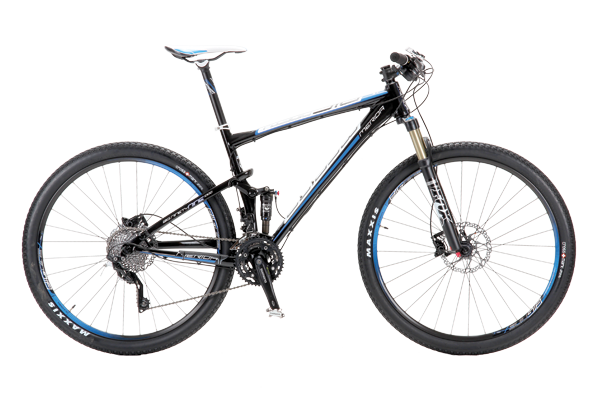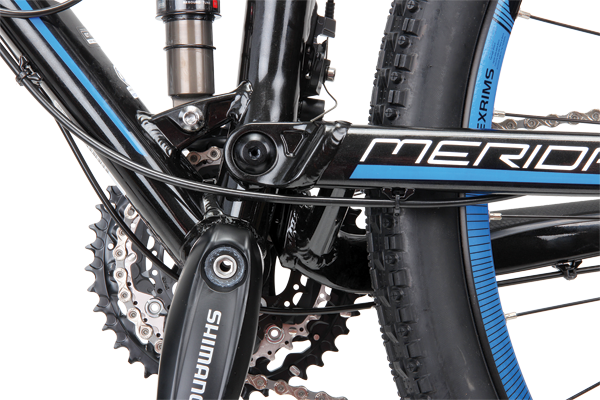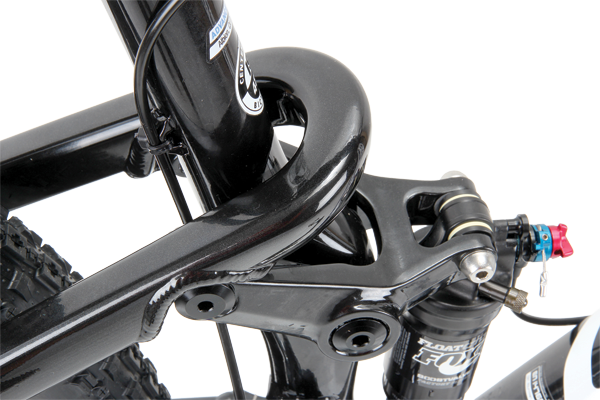Merida Big Ninety-Nine 1000
 The Merida Big Ninety-Nine – let’s just call it the BNN from now on – is Merida’s first go at a dual suspension 29er. Merida produces more high-quality bikes than anyone else on the planet, the majority being bikes branded other than Merida, so you’d expect the BNN to be a well-constructed machine, although you could say it’s a year or two late to the 29er party.The BNN is an unashamedly tweaked and scaled-up copy of Merida’s pre-existing 26-inch wheeled Ninety-Nine XC bike. For mine it’s a good-looking machine with straight tubes and a compact seat tube-mounted rocker link. Traditional and devoid of trend-driven fluff, there’s not a pointless acronym printed anywhere on the frame—just how I like it.
The Merida Big Ninety-Nine – let’s just call it the BNN from now on – is Merida’s first go at a dual suspension 29er. Merida produces more high-quality bikes than anyone else on the planet, the majority being bikes branded other than Merida, so you’d expect the BNN to be a well-constructed machine, although you could say it’s a year or two late to the 29er party.The BNN is an unashamedly tweaked and scaled-up copy of Merida’s pre-existing 26-inch wheeled Ninety-Nine XC bike. For mine it’s a good-looking machine with straight tubes and a compact seat tube-mounted rocker link. Traditional and devoid of trend-driven fluff, there’s not a pointless acronym printed anywhere on the frame—just how I like it.
Merida has matched 106mm of rear wheel travel with 100mm up front, which is pretty standard fare for an XC-oriented dually. The frame is alloy in its construction, which is in keeping with the $2,799 price point. Alloy frames have plenty to offer, especially when well executed, and it’s fair to say that Merida has a body of experience that few could compete with. The welds across the BNN are incredibly tidy and the head tube has been double pass welded which creates a seamless appearance in this area. The deep gloss paint and pin sharp graphics complement the slick fabrication of the frame and it’s fair to say that the BNN looks like a bike that could cost far more than it does.
Speaking of the price tag, Merida haven’t given their firstborn 29er dually the benefit of over-protective parenting. It’s been dropped straight into the $2,500-3,500 cross-country dually market—the veritable bang-for-buck epicentre of the MTB world. All the big players are represented in this area and you’ll even find entry level models from some of the more boutique marques, and they’re all playing hardball to score with riders looking to buy their first ‘proper’ dually. On-paper comparisons of derailleurs, forks and brakes will be made between the Merida and its competitors which all share alloy frames. Many of these frames will be adorned with corny acronyms espousing the virtues of the particular suspension design or a minor feature.
Mild Mannered Merida
Merida has played safe with the BNN. There is no fancy suspension system to speak of, just a simple and cleanly executed single-pivot design which actuates the shock via a seat tube mounted rocker link. Measuring 450mm, the chainstays are neither long nor short at 450mm, so there’s nothing to complain about and equally nothing that will have jaws colliding with top tubes in amazement. Instead the BNN shows an admirably clean execution of dependable design and geometry.
The tapered head tube uses an internal headset to help keep the bars at a reasonable height, and the bottom bracket is a traditional threaded type. Merida did let their hair down a little when designing the seat tube; it’s slightly bowed to make room for the rear wheel, and the mounting point for the rocker link has been nicely hydroformed into the otherwise round tube. The down tube is wide and flat-bottomed and the top tube almost a standard round beam with the exception of a small hydroformed buttress which supports the seat tube junction.
All of the BNN models share the same geometry; from the 1000 that we reviewed up to the carbon framed ‘Pro’ model. The alloy rear end and Fox shock is also shared between all BNN models in Australia, which is something that can’t be said for many other brands. That means the entry-level BNN 1000 offers the same rear-end performance as the top of the line model—not shabby for an entry-level machine!
The short-stroke Fox CTD shock has been tuned to suit the Merida and comes with Fox’s handlebar mounted remote lockout lever. This makes it easy to firm up the rear end without taking a hand off the bar, although the lever is quite large and located in a prime position to be damaged in a crash. The rocker link is forged and quite short which helps reduce flex, and the seat stay is formed by one U-shaped tube that negates the need for a welded cross brace. It looked odd to me at first but after gazing at it a little longer, I realised it was a neat way to make a simpler, stronger frame. All of this supports a 142x12mm thru-axle for the rear wheel, which again makes for a stiff assembly without the need for any weird or complex engineering stunts.
Merida doesn’t pull any stunts on the rest of the BNN either. The spec is totally in keeping with the personality of the frame; functional and well-engineered without any showboating. Merida has played almost every card in the Shimano deck on the BNN. The drivetrain is a mixture of SLX shifters and front derailleur with an XT rear derailleur for a little showroom pizzazz.
Interestingly Merida has chosen an Octalink crank instead of the newer generation external bottom bracket Hollowtech II design. I found this surprising and I can’t actually remember the last time I rode a bike that did not use an external bottom bracket. For those who aren’t familiar with Octalink, it’s basically an older design that houses the bearings within the frame. As a result, the bearings and spindle are smaller than Hollowtech II. In theory it’s heavier and not as stiff but for me it made no discernible difference on the test bike. If there’s any tangible difference, it’s likely to be a shorter bottom bracket life due to the smaller bearings.

Shimano also handles the braking duties and supplies the hubs. The M596 brakes deserve special mention. These Deore-level brakes lack the absolute power of Shimano’s top tier models, but the ergonomics of the lever blade are truly top notch and the modulation is fantastic. The SLX hubs are made to suit Shimano’s Centre Lock disc rotors and integrate seamlessly with the brakes as a result. They roll smoothly and the cup and cone style bearings can be overhauled by a home mechanic with a little practice and a couple of basic tools.
Overall the BNN sports a very functional spec. the only obvious downside of the entry-level spec is its weight. You can’t expect to spend this kind of cash and walk away with a feather-light machine—it just ain’t gunna happen! Of course there’s plenty of scope to upgrade and improve the parts, but the real question is whether it’s worth it. So is the BNN a bike that warrants long-term upgrades or is it a keeper best left on entry-level duties? The best way to find out is on the trail, so here we go…

Setting the Fox shocks was a simple task as always. A bit over 20 precent sag generally works for me on most XC bikes and this held true on the BNN. Once rolling the BNN puts the rider in a very neutral XC position, evenly weighted between the big wheels and with the body positioned for effective pedalling.
I had to replace the stock Merida seatpost with a longer one from my personal stash—at 350mm the stock Merida post is certainly a bit on the short side. I do have a long inseam, but nothing that puts me into the circus freak category. At a touch under 180cm tall, I’m bang-on for the 19-inch frame and I’m sure taller folk will find themselves on this size too. It’s an easy fix but an unfortunate oversight. On the flip side it means that the front triangle is relatively compact, so you’re less likely to collide with it during an unplanned dismount. It also helps the bike feel more manoeuvrable when you’re moving around on it.

This is an XC bike, but as dropper posts become more common place on the trail, it’s worth noting that the Merida uses a readily available 31.6mm diameter seatpost, so there is no shortage of dropper posts that would suit the BNN. As a bonus the front derailleur cable is routed along the underside of the top tube and held on by zip ties. Attaching a remote cable for a dropper post would be a total no brainer on the BNN, although it would add another remote to the handlebars in addition to the bulky Fox lever that locks the rear shock.
Simple & Smooth
Speaking of the Fox shock, it does a nice job in the back end of the BNN. The rear feels planted to the trail without wallowing around. I could achieve full travel on every ride but never noticed the bike bottom out. If anything the BNN pedalled like a bike with less travel. It feels very responsive under power and standing to sprint or climb is no problem with the shock in the open setting. I only ever used the handlebar remote to firm the shock for sections of road between trails or on very smooth and long fire road sections.
In the open setting, the Merida is really an XC bike on a mission when covering broken ground. You can sit and pedal through choppy fire trails and blast around twisty singletrack without having to worry about whether the shock should be open or closed—open is fine. Up front the Fox fork is a slightly different experience. I found the three-step CTD knob easy and intuitive to use, and in most situations the slightly firmer ride of the ‘Trail’ setting matched the feel of the rear shock in the open setting just nicely. When ridden like this the fork and shock both ride high in their travel and keep the bike feeling alert.
The BNN doesn’t shine in any one particular facet on the trail. Descending with the very useable suspension travel and big wheels is good enough for an XC bike. The skinny quick-release axle equipped fork does make you aware of the price point when you take successive hits, as do the brakes once things get really steep, but five years ago we would have thought these components were pretty great in their own right.

Climbing is excellent, even with the rear shock open. Pedalling efficiency is barely compromised and leaving the shock active helps with traction on rutted or rocky climbs. The BNN will never be a gravity cheater simply due to its weight, but once you get it moving there is nothing about it that will slow you back down.
Cross-country singletrack is genuinely pleasurable. With the fork in the Trail mode the BNN doesn’t dive entering corners and the snappy pedalling response allows you to accelerate out of corners without getting out of the saddle. You simply devote your thoughts to steering and being the motor, as you don’t need to compensate for any handling quirks when cruising through the trees.
Although not razor-sharp fast in its handling, the BNN is far from a general duties trail bike in the modern sense. The chainstays happily accepted the stock 2.1-inch Maxxis Crossmark tyres, but a bigger bagged tyre with more aggressive side knobs would be pushing the limits of available clearance. More importantly, there is nothing about the BNN that makes you want to get funky on the trail. You could pop off a root or take a silly highline to the side of the trail, but the BNN isn’t whispering ‘do it’ into your ear as you go.

Although conservative and worthy of upgrade, the stock parts really are spot on for the intend market. Fast rolling racy tyres, remote handlebar lockout for the rear end and a moderate-width flat handlebar all add up to an XC bike without pretension. It’s not a bike for scoring podiums in short track eliminator events but it will comfortably clock up the miles and do so in a smart and efficient manner.
It’s fair to say that the BNN exceeded my expectations, especially given the relatively affordable price point. When we first met, I was immediately impressed by how classy it looked, and we all know that first impressions count. From there I developed a bit of a soft spot for it and by the end of the review I really wanted to throw on some better parts to tart it up. Some lighter wheels, more powerful brakes, a wider bar and thru-axle fork; it would have looked great and the simple and unassuming frame would have easily held its own amongst more highly credentialed company.
What I appreciated most was the hype-free approach. A read of the Merida website doesn’t leave you thinking that this bike is the answer to the world’s woes. It doesn’t scream at you or even suggest that it might be better than this bike or that. Heck, the suspension design doesn’t even have a trademarked name or an acronym! It’s fluff-free, functional and does exactly what it’s meant to when the tyres hit the dirt!
Thumbs Up
Efficient suspension design
Classy frame finish
Rides like a more expensive bike
Thumbs Down
Not as versatile as some
Overall weight
Short seatpost
Specifications
Frame: Hydroformed Alloy
Shock: Fox CTD Remote 106mm travel
Fork: Fox CTD Performance 15QR 100mm travel
Headset: FSA No.55E 1 1/8 - 1 1/2
Handlebars: Merida Pro Alloy flat 680mm
Stem: Merida Pro Alloy
Shifters: Shimano SLX
Front Derailleur: Shimano SLX
Rear Derailleur: Shimano XT
Cassette: SRAM PG1070 11/36 10-speed
Chain: KMC X10
Cranks: Shimano M522 Octalink 24/32/42
Bottom Bracket: Shimano Octalink
Pedals: Shimano M520
Brakes: Shimano M596
Rims: Merida Big Nine Pro D
Spokes: Black Stainless
Hubs: Shimano SLX
Tyres: Maxxis Crossmark 2.1
Saddle: Merida Pro SI
Seatpost: Merida Pro alloy
Weight: 13.6kg including pedals (19-inch frame 2,910g)
Available Sizes: 17, 19 (tested), 21 and 23-inch
Price: $2,799
Distributor: Advance Traders 1300 361 686 / www.merida.com.au


 The Merida Big Ninety-Nine – let’s just call it the BNN from now on – is Merida’s first go at a dual suspension 29er. Merida produces more high-quality bikes than anyone else on the planet, the majority being bikes branded other than Merida, so you’d expect the BNN to be a well-constructed machine, although you could say it’s a year or two late to the 29er party.The BNN is an unashamedly tweaked and scaled-up copy of Merida’s pre-existing 26-inch wheeled Ninety-Nine XC bike. For mine it’s a good-looking machine with straight tubes and a compact seat tube-mounted rocker link. Traditional and devoid of trend-driven fluff, there’s not a pointless acronym printed anywhere on the frame—just how I like it.
The Merida Big Ninety-Nine – let’s just call it the BNN from now on – is Merida’s first go at a dual suspension 29er. Merida produces more high-quality bikes than anyone else on the planet, the majority being bikes branded other than Merida, so you’d expect the BNN to be a well-constructed machine, although you could say it’s a year or two late to the 29er party.The BNN is an unashamedly tweaked and scaled-up copy of Merida’s pre-existing 26-inch wheeled Ninety-Nine XC bike. For mine it’s a good-looking machine with straight tubes and a compact seat tube-mounted rocker link. Traditional and devoid of trend-driven fluff, there’s not a pointless acronym printed anywhere on the frame—just how I like it.






